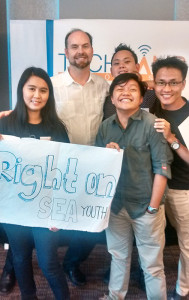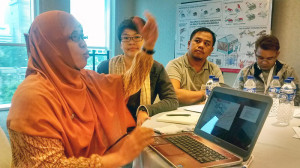Boot camp builds tech networks in Southeast Asia
By Michael McCabeMarch 16, 2015
Jakarta, Indonesia—A third of individuals in Asia are using the Internet, according to the United Nations International Telecommunication Union. In Indonesia, where less than 1 percent of the population was logging on to the web in 2000, today more than 15 percent are online. In Vietnam, only 0.25 percent of people used the Internet in 2000, compared to the nearly 44 percent of the population on the web now.
As access to information and communications technology expands in Southeast Asia, new opportunities are opening up to build virtual networks of social change agents and develop new tools to support community development.
For civil society activists in countries still at the beginning of their own technology and Internet booms, however, spreading the technology for development revolution and gaining the skills and knowledge to do so can require some extra support
“In my country, since most of our people are not familiar with technology, I never saw technology as a tool to spread our cause,” says Khin Khin Kyaw Kyee, Program Coordinator at the Institute for Political and Civic Engagement (iPACE) in Mandalay, Myanmar.
In January, Khin joined more than 50 other civic leaders from 43 nongovernmental organizations across 10 Southeast Asian countries to participate in a four-day TechCamp in Jakarta.
At the camp, which was supported by the U.S. State Department and the Community of Democracies, civil society leaders learned how best to integrate technology into their efforts for social change and leverage e-communication to mobilize citizens.
The camp was led by five regional instructors and Creative Associate International’s Capacity Building and Training expert Michael McCabe, who trained participants on capacity building technologies including the e-learning platform CreativeU.
Tech for social impact

Between sessions on online learning, creating a digital presence, mapping, blogging and using mobile applications to strengthen organizations, participants developed strategies and innovations to take back home to boost emerging civil society movements. Some of these innovations included ideas for youth engagement through video messaging, social media outreach to marginalized groups and mobile applications to track and protect journalists in conflict.
“The energy and creativity among these NGO leaders and the Tech Camp trainers was mutually infectious,” says Sean Carroll, Senior Director at Creative. “Of course these leaders, mostly youth, already know and use technology every day. But by leveraging tech tools such as global online learning and networking, apps development, social media maximization and more in their civil society work and professional lives, they have great potential to impact youth leadership, human rights, inclusion and good governance. This is a great initiative.”
During the camp, Khin and her team developed a prototype for “RightOn SEAsia Youth,” a portal to engage young people across the region in civic participation and activism.
“I am excited that I have now learned to use social media and applications effectively to promote democracy,” she says.
The trainers, for their part, were equally excited to be educating and supporting a generation of change-makers on how to use technology to amplify their efforts.
This camp is “a great opportunity to help so many young leaders dedicated to improving their communities” and teach them “how to use technology for greater good,” says blogging trainer Anton Diaz, Founder of Our Awesome Planet and a top food and travel blogger in Asia.
Networks of change-agents

In addition to the skills gained, TechCamp provided a space for Southeast Asian civil society leaders to meet, share lessons learned, collaborate on obstacles and build connections that will strengthen the efforts of civil society throughout the region.
“TechCamp gave me a network of colleagues and technicians to open vast new possibilities,” says Khin. “I was also able to connect with other [civil society organization] leaders and trainers from the TechCamp and learn from each other about challenges and best practices to overcome the problems.”
Through more than 40 similar TechCamps in 34 countries to date since 2010, the State Department’s Civil Society 2.0 initiative is connecting civic organizations and leaders globally to one another, as well as to new and emerging technologies to solve community challenges. Creative will again join efforts with the TechCamp in Belfast Ireland in May 2015 and will support the State Department on integrating technology into education in refugee settings.
“Advances in technology make the world boundary-less,” says Anisah Abdul Khalid, former president of SMU Islamic Banking and Finance Society and a participant in the Jakarta TechCamp.
Now, with 50 Southeast Asian civil society leaders equipped with the technological know-how to ramp up their social change efforts back home, even more boundaries will be broken as more connections, both digital and on-the-ground, are made and strengthened.

